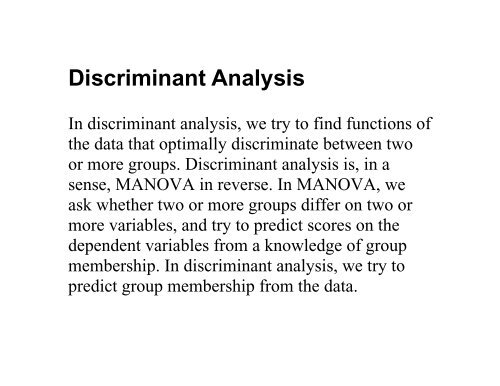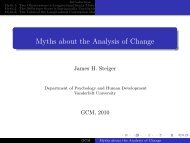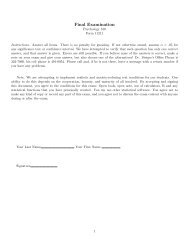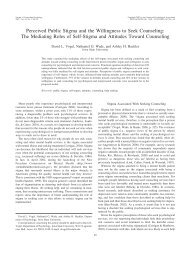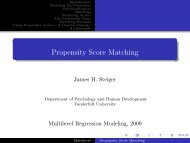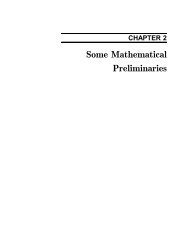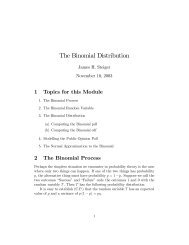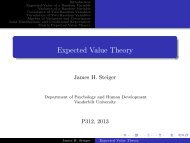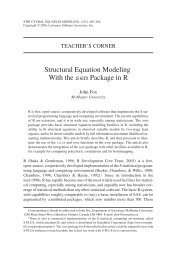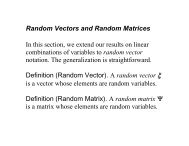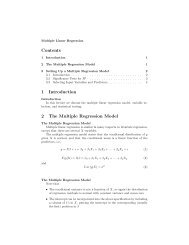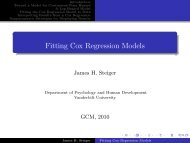Discriminant Analysis - Statpower
Discriminant Analysis - Statpower
Discriminant Analysis - Statpower
Create successful ePaper yourself
Turn your PDF publications into a flip-book with our unique Google optimized e-Paper software.
<strong>Discriminant</strong> <strong>Analysis</strong><br />
In discriminant analysis, we try to find functions of<br />
the data that optimally discriminate between two<br />
or more groups. <strong>Discriminant</strong> analysis is, in a<br />
sense, MANOVA in reverse. In MANOVA, we<br />
ask whether two or more groups differ on two or<br />
more variables, and try to predict scores on the<br />
dependent variables from a knowledge of group<br />
membership. In discriminant analysis, we try to<br />
predict group membership from the data.
A Caveat<br />
There are a number of different ways of arriving at<br />
formulae that produce essentially the same result<br />
in discriminant analysis. Consequently, different<br />
computer programs or books may give different<br />
formulae that yield different numerical values for<br />
some quantities. This can be very confusing.
Linear <strong>Discriminant</strong> Function – Two Group<br />
Case<br />
4<br />
3.5<br />
3<br />
2.5<br />
4.5 5.5 6 6.5
4<br />
3.75<br />
3.5<br />
3.25<br />
4.4 4.6 4.8 5.2 5.4 5.6 5.8<br />
2.75<br />
2.5<br />
2.25
The linear discriminant function was proposed by<br />
Fisher (1936). Suppose we have N 1 independent<br />
observations from population 1 and N 2<br />
independent observations from population 2, and<br />
we have recorded p measurements. The sample<br />
mean vectors are x 1 and x 2, and the grand mean is<br />
N<br />
x<br />
N<br />
+<br />
+<br />
N<br />
N<br />
1 1 2 2<br />
x =<br />
(1)<br />
1 2<br />
x
Following Morrison (1983), suppose we indicate<br />
group membership with the dummy variable<br />
y<br />
i<br />
⎧ N2<br />
⎪N<br />
+ N<br />
= ⎨<br />
⎪ − N1<br />
⎪ ⎩N<br />
+ N<br />
1 2<br />
1 2<br />
,(group 1)<br />
,(group 2)<br />
(2)<br />
One may easily show (Morrison, 1983, p. 258) that<br />
the vector of estimated regression coefficients for<br />
predicting the y scores from the x variates is
( )<br />
βˆ = cA −1 x −x (3)<br />
1 2<br />
where<br />
c<br />
=<br />
NN 1 2/<br />
( N1+<br />
N2)<br />
[<br />
−1<br />
NN ( N N )]( x x )′<br />
A ( x x )<br />
1 + / + − −<br />
1 2 1 2 1 2 1 2<br />
(4)<br />
The predicted y scores are<br />
( )<br />
y = βˆ<br />
′ x − x (5)<br />
ˆi<br />
i
We can use the regression formula (5) to classify<br />
scores, i.e., attempt to categorize them into groups.<br />
A score y ˆi classified as being in the group whose<br />
predicted score mean is closest to it. Since the<br />
group means are<br />
βˆ′ ( x − x ) and ˆ′ ( − )<br />
the midpoint, or cutpoint, is<br />
1<br />
( ) ˆ ( )<br />
β x x (6)<br />
βˆ′ x1− x + β′<br />
x2 − x<br />
ˆ ⎛ x1+<br />
x<br />
′<br />
2<br />
= β −<br />
⎞<br />
⎜ x ⎟ (7)<br />
2 ⎝ 2 ⎠<br />
2
Recall that group 1 is associated with positive<br />
scores and group 2 negative scores. Consequently,<br />
if a predicted score y ˆi is above the cutpoint in<br />
Equation (7), it is classified in group 1, otherwise<br />
in group 2. That is, a score is classified in group 1<br />
if<br />
or<br />
ˆ<br />
1 2<br />
( ) ˆ ⎛ x + x<br />
β′ x<br />
⎞<br />
i − x > β′<br />
⎜ −x ⎟ (8)<br />
⎝ 2 ⎠
ˆ ˆ ⎛ x1+<br />
x2<br />
β′ x<br />
⎞<br />
i > β ′ ⎜ ⎟<br />
(9)<br />
⎝ 2 ⎠<br />
Notice that the regression coefficients can all be<br />
multiplied by a common constant c without<br />
affecting the inequality. Moreover, the pooled<br />
estimate S of the common covariance matrix can<br />
be calculated as<br />
1<br />
S=<br />
A (10)<br />
N + N −2<br />
1 2
so ˆβ in Equation (9) can be replaced by<br />
−1<br />
−1<br />
A ( x1−<br />
x 2)<br />
or a= S ( x1−x 2)<br />
, since either<br />
substitution involves eliminating a multiplicative<br />
constant. With that substitution, we get<br />
w<br />
′ −1<br />
= ax ′ = x −x S x (11)<br />
( )<br />
1 2<br />
which is known as the linear discriminant<br />
function. The cutoff point is halfway between the<br />
averages of w, or at
′<br />
( x −1 −1<br />
− x ) S ( x + x ) S ( x + x )<br />
= a ′<br />
(12)<br />
2 2<br />
1 2 1 2 1 2<br />
So effectively, the classification rule becomes<br />
assign to population 1 if<br />
x −x ′ S x− x − x ′ S x + x > (13)<br />
−1 ( ) 1<br />
−1<br />
( ) ( )<br />
1 2 2 1 2 1 2 0<br />
and assign to population 2 otherwise.
Of course, we could generate a different<br />
discriminant function for each group and use a<br />
different decision rule: assign a subject to the<br />
group whose function value is higher. Equation<br />
(13) can be broken down into two formulae,<br />
and<br />
f<br />
f<br />
xS ′ x xS ′ x bx ′ (14)<br />
−1 1 −1<br />
1 = 1 −<br />
2 1 1 = 1 + a1<br />
x ′ S x x ′ S x b ′ x (15)<br />
−1 1 −1<br />
2 = 2 −<br />
2 2 1 = 2 + a2
with, for example,<br />
′ −1<br />
b′ = x S (16)<br />
1 1<br />
and<br />
a<br />
xS ′ x bx ′ (17)<br />
1 −1<br />
1<br />
1 =−<br />
2 1 1 =−2<br />
1 1<br />
Equations (14)–(17) yield the “Fisher discriminant<br />
function” weights and constant printed by SPSS,<br />
except for one additional element. If the groups<br />
have a different prior likelihood of occurrence, the
above function values will lead to a substantial<br />
amount of classification error. This can be<br />
corrected by incorporating the probabilities p j of<br />
being in group j by using the following formula<br />
*<br />
j j j<br />
a = a + ln( p )<br />
(18)<br />
This constant is used along with<br />
′ −1<br />
b′ = x S (19)<br />
j<br />
j<br />
to generate the scores for group j.
The individual is classified into the group whose<br />
score is highest. In practice, prior probabilities are<br />
often not known, in which case the estimates<br />
pˆ<br />
j<br />
N j<br />
= (20)<br />
N •<br />
are often employed as a default.
Example. Morrison (1990, page 143) gives data for<br />
49 subjects, 12 diagnosed with “senile factor<br />
present” and 37 diagnosed with “no senile factor.”<br />
The data are available online in the file<br />
morrisonEx43.sav. The Wechsler Adult<br />
Intelligence scale was administered to all subjects<br />
by independent investigators, and scores for 4<br />
subtests (Information, Similarities, Arithmetic,<br />
Picture Completion) recorded. So the data set<br />
consists of 49 observations on 5 variables.
This data set is analyzed several times in<br />
Morrison’s text. In this case, we will examine a<br />
standard 2-group linear discriminant analysis the<br />
way Morrison reports it, and the way SPSS reports<br />
it.<br />
Morrison computes the linear discriminant<br />
function using Equation (11), and, for each subject,<br />
compares the computed function to the cutoff<br />
value in Equation (12).
In this case,<br />
−1<br />
S is given by<br />
′<br />
1 2 3.81757 4.23423 2.98649 3.22297<br />
( x − x ) = [ ]<br />
So the discriminant function is
y = .0264 x + .2075 x + .0086 x + .4459x<br />
(21)<br />
and the cutoff point is 4.750.<br />
1 2 3 4<br />
SPSS reports coefficients (“Unstandardized<br />
Canonical Coefficients”) that are proportional to<br />
those in Equation (11) . These are divided by the<br />
standard deviation of the predicted scores, i.e.,<br />
(<br />
−<br />
)<br />
−<br />
′<br />
1/2<br />
* 1<br />
a = aS a a (22)
Note that variables x 1 and x 3 do not appear to have<br />
much influence in discriminating between the<br />
senile and non-senile group.<br />
Incidentally, one important outcome of the<br />
analysis is the classification matrix, which shows<br />
the result of applying the discriminant function<br />
classification rule.
Using all 4 variables, we get the following:<br />
Original<br />
Count<br />
%<br />
Classification Results a<br />
SENILE<br />
0<br />
1<br />
0<br />
1<br />
Predicted Group<br />
Membership<br />
0 1 Total<br />
29 8 37<br />
4 8 12<br />
78.4 21.6 100.0<br />
33.3 66.7 100.0<br />
a. 75.5% of original grouped cases correctly classified.<br />
In this case, the misclassification rates are rather<br />
high. Moreover, these classification rates are<br />
probably unduly optimistic. We can improve<br />
things.
But first, let’s perform the analysis using the more<br />
general approach employed by SPSS.<br />
SPSS can report a linear discriminant function for<br />
each group, as in Equations (14)–(15).
Classification Function Coefficients<br />
INFO<br />
SIMILAR<br />
ARITH<br />
PICCOMPL<br />
(Constant)<br />
SENILE<br />
0 1<br />
.760 .734<br />
-.239 -.447<br />
.491 .483<br />
.811 .366<br />
-10.382 -5.632<br />
Fisher's linear discriminant functions<br />
To perform classification, you compute the two<br />
functions, and assign an individual to the group<br />
with the higher score.
Now, if we drop the two non-contributing<br />
variables and redo the analysis, we get<br />
Original<br />
Count<br />
%<br />
Classification Results a<br />
SENILE<br />
0<br />
1<br />
0<br />
1<br />
Predicted Group<br />
Membership<br />
0 1 Total<br />
29 8 37<br />
4 8 12<br />
78.4 21.6 100.0<br />
33.3 66.7 100.0<br />
a. 75.5% of original grouped cases correctly classified.<br />
Exactly the same as before.
However, we have not yet employed the correction<br />
for prior probabilities. If we do that, we get<br />
Original<br />
Count<br />
%<br />
Classification Results a<br />
SENILE<br />
0<br />
1<br />
0<br />
1<br />
Predicted Group<br />
Membership<br />
0 1 Total<br />
37 0 37<br />
6 6 12<br />
100.0 .0 100.0<br />
50.0 50.0 100.0<br />
a. 87.8% of original grouped cases correctly classified.


